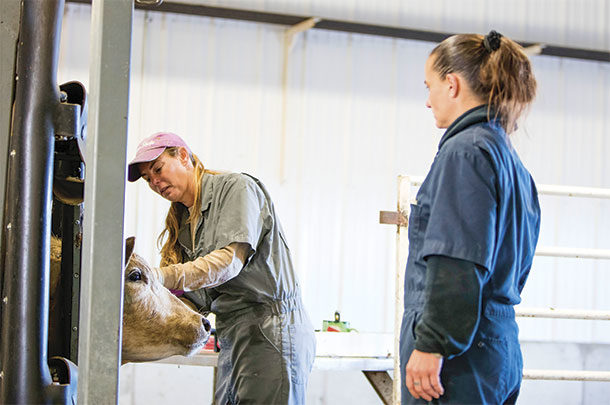After all, preventing BRD with good management, a strong veterinary-client-patient relationship and vaccination is much more cost-effective than treating it.
As you weigh needed treatment options with your veterinarian, cost per dose is an important part of the discussion. But demonstrated efficacy also is an important consideration. There is new peer-reviewed research that you and your veterinarian can evaluate that shows the likelihood of success for several injectable antibiotics to treat BRD the first time, reducing re-treatments.
Even if an antibiotic treatment has a higher initial cost, if it significantly reduces the need for re-treatments than another option, it could be more cost-effective overall. Here are five reasons why ineffective BRD treatment can cost more.
1. Treatment costs aren’t just the price of one dose
The average cost of treatment for a single case of BRD is $23.60. But if BRD treatment is ineffective and a second or third treatment with a different product is needed, this gets more expensive. An antibiotic that works better on the first injection, and works for a longer period of time, can help reduce the number of doses you need to use – and buy – overall. According to the new meta-analysis research I mentioned earlier, some antibiotics were found to be only half as effective as other options for treating BRD the first time. By using a less effective antibiotic for your first treatment, you will need to factor in the cost of purchasing nearly double the re-treatment doses on top of the first treatment price.
2. Treating cattle costs money but also takes time
With more second and third treatments comes more time pulling and re-treating cattle for you and employees. Again, let’s compare costs from using an antibiotic that’s demonstrated to be only half as effective as another option.
A simple way to estimate the impact on labor would be to double the amount of time your employees spend re-treating cattle. This could easily be one to two hours in a 10-hour day. Plus, this extra time spent re-treating cattle can lead to decreased efficiency, unengaged employees and less time spent on animal husbandry and other things to improve overall cattle health and well-being.
3. More mortality means losing more than the purchase price
For every increase in mortality, there are additional increases to the breakeven for your operation. Some antibiotics could be almost doubling mortalities on your operation due to poorer efficacy, studies have found. When only considering the purchase price of the calf, assuming $900 per head, every 1% increase in mortality adds a $9-per-head cost to your breakeven.
But when you lose an animal to BRD, you lose more than what you paid for that calf. You have to factor in the additional expenses prior to death, including treatment and re-treatment antibiotics purchased to treat BRD, labor costs of pulling and re-treating that animal multiple times, arrival processing costs, feed costs and lost return.
4. Chronics can be costlier than mortalities
Better treatment response also leads to fewer costly, chronic cattle. Chronic cattle experience permanent health damage and add costly long-term performance losses. Some research shows chronics can be costlier than dead cattle when you consider cost of feed, yardage interest and opportunity cost.
This study found net return to be up to $30.37 per head for cattle never treated for BRD compared with -$45.52 per head for cattle receiving more than three BRD treatments, or a difference of $75.89 per head. But for easy estimating, we assume chronics cost at least half of your mortality costs.
5. Longer bouts of BRD negatively impact performance
Decreasing re-treatments with a more effective BRD treatment not only means having more first-time treatment success, but also cattle that are on feed for less time and gain weight more effectively. If you have nearly twice as many prolonged BRD cases with an ineffective first treatment for BRD, this can negatively impact gain, feed efficiency, carcass quality grade, hot carcass weight, carcass yield grade and, ultimately, your net revenue. You could lose nearly $23.23 per head in return for cattle treated once and $30.15 per head for cattle treated twice, one study found.
When it comes to treating BRD, there’s a lot that can add up. Yes, some antibiotics can be expensive, but when you add up the cost of re-treatments, chronics, mortalities and performance losses you might have by using a less effective antibiotic, this almost always costs more. Starting with a more effective BRD treatment, as demonstrated in an objective study, or, rather, improving your first-treatment success, is one way to help reduce the number of antibiotic treatment courses and the significant impact BRD has on cattle health, productivity and your profits. Treating BRD successfully the first time is not only better for your cattle and your crew, but also for your wallet.
Your veterinarian is the best resource to help you determine if your antibiotic treatment is costly or cost-effective for your operation. Please contact me if you would like more information about how to calculate how much BRD re-treats, chronics, mortalities and performance losses are currently costing your operation with your BRD treatment program. ![]()
PHOTO: Antibiotics can be expensive, but when you add up the cost of re-treatments, chronics, mortalities and performance losses, skimping on effective antibiotics almost always costs more. Photo courtesy of Zoetis.
References omitted but are available upon request. Click here to email an editor.

-
Shawn Blood
- Beef Technical Services
- Zoetis
- Email Shawn Blood







